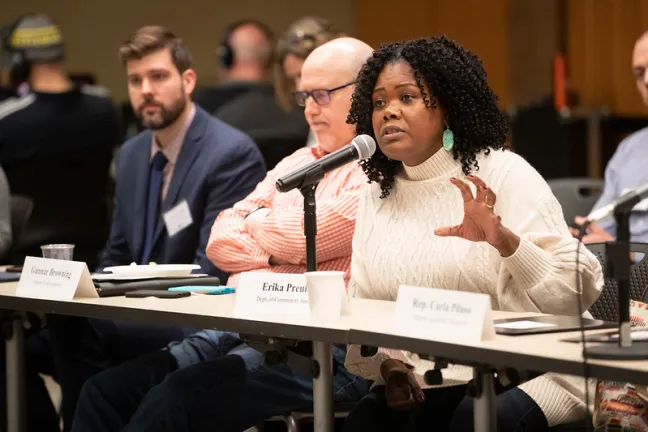At a time of racial unrest over police violence and systemic racism, punctuated by the deaths of George Floyd and Breonna Taylor at the hands of law enforcement, Department of Community Justice (DCJ) director Erika Preuitt and Adult Services Division director Jay Scroggin shared their report of electronic monitoring of community members involved with the criminal justice system.
The briefing was originally requested by Multnomah County Commissioner Susheela Jayapal in June at the end of the FY 2021 budget adoption process, with the intent to gain a greater understanding on a series of policy topics as the Board of County Commissioners considered future legislative or budget action.
DCJ’s report was designed to take a deeper look at the department's use of electronic monitoring, its efficacy, and its impact on Black, Indigenous and people of color (BIPOC) communities, who are often overrepresented in the justice system.
“The County has been intentional about listening to the voices of communities most impacted by inequitable systems, to advocates, and to people with lived experience. Their recent challenge to dramatically reimagine public safety reinforces the importance and urgency of this work,” said Chair Deborah Kafoury at the briefing. “And while it’s important to acknowledge the changes that are underway, we know more needs to be done.”
The report found that in 2019, 1,211 electronic monitoring units were administered post-adjudication. According to Scroggin, there are two types of electronic monitoring: GPS, primarily used for house arrest, curfew and general movement tracking, and SCRAM, which monitors alcohol consumption.
Scroggin says that GPS electronic monitoring generally has few rehabilitative benefits. A review of scholarly articles provides additional evidence that there is no clear consensus on the effects of electronic monitoring on recidivism rates.
“Electronic monitoring is really a tool just to track how people are doing. I don’t think that in any use of electronic monitoring, do we see [...] at DCJ this as a tool to change the behavior,” Scroggin says.
“We think the other things that we do at the Department of Community Justice do change behavior, like the programming, the interventions, the skill-building that we give.”
Despite not being part of the County’s rehabilitative opportunities, electronic monitoring can improve community safety while limiting the number of incarcerated individuals, Scroggin said.
81-percent of individuals post-adjudication are electronically monitored due to preventative conditions, he said.
“Those conditions fall almost every time on domestic violence, they often fall on sex offender case loads, and they are pretty common in the gang unit,” says Scroggin.
For victims of domestic violence or sexual assault, Scroggin says electronic monitoring makes them feel safer. And for those in the criminal justice system for crimes related to alcohol use disorder, SCRAM electronic monitoring can even help them avoid using.
“It’s a tool for accountability,” says Scroggin. “It basically acts as a deterrent to doing something wrong, for instance using alcohol. Or when we are using the GPS, it should deter someone from going to an area they shouldn’t and it allows us to keep tabs on someone.”
Additionally, between 2017 and 2019, electronic monitoring saved over 150,000 jail beds.
However, the report also found that African Americans are overrepresented not only in the Multnomah County justice system, but also in the number of community members given electronic monitoring. While 21% of community members involved in the justice system are African American, they comprise 36% of electronically monitored individuals post-adjudication.
Since the beginning of the COVID-19 pandemic in March, DCJ has limited the use of electronic monitoring from 19 to 29 devices administered per month to 2 to 9 devices. Preuitt says this reduction is largely due to concerns around spreading COVID-19.
Going forward, Preuitt plans to wait to make a decision to resume the pre-pandemic rate of electronic monitoring as she and Scroggin continue to study the effects of electronic monitoring on various overrepresented populations, such as African Americans.
“Some of the national conversation with my colleagues in this field is the image of electronic monitoring being a virtual shackle in our communities,” Preuitt says. “And I think that that’s something that we have to grapple with as a system, as well as talking to our victims about the impact of public safety.”
She also emphasized steps Multnomah County has taken towards culturally responsive rehabilitation services for individuals of color involved in the justice system.
“We are trying to enhance those services so we have more alternatives [from] things like electronic monitoring and jail, so that we can really help people change their behavior,” Preuitt says.
“We need to be investing in things that help people change their behavior.”
The board will hear additional budget note briefings in the coming month from the Multnomah County Sheriff's Office, as it continues to evaluate potential reforms to the criminal justice system.
“It’s a system that is less restrictive than physical prisons, but ultimately can perpetuate the obstacles to freedom and the injustice created by our systems of prosecution and punishment,” says Commissioner Jayapal.
“There may be situations where electronic monitoring really does promote public safety. But we need to be sure we’re asking how and why we use it, who it protects, who it hurts, whether it’s really necessary, and what the alternatives might be.”


